Business
Lisa Frank: A Look Behind The Rainbow
Published
3 years agoon
By
Akilah S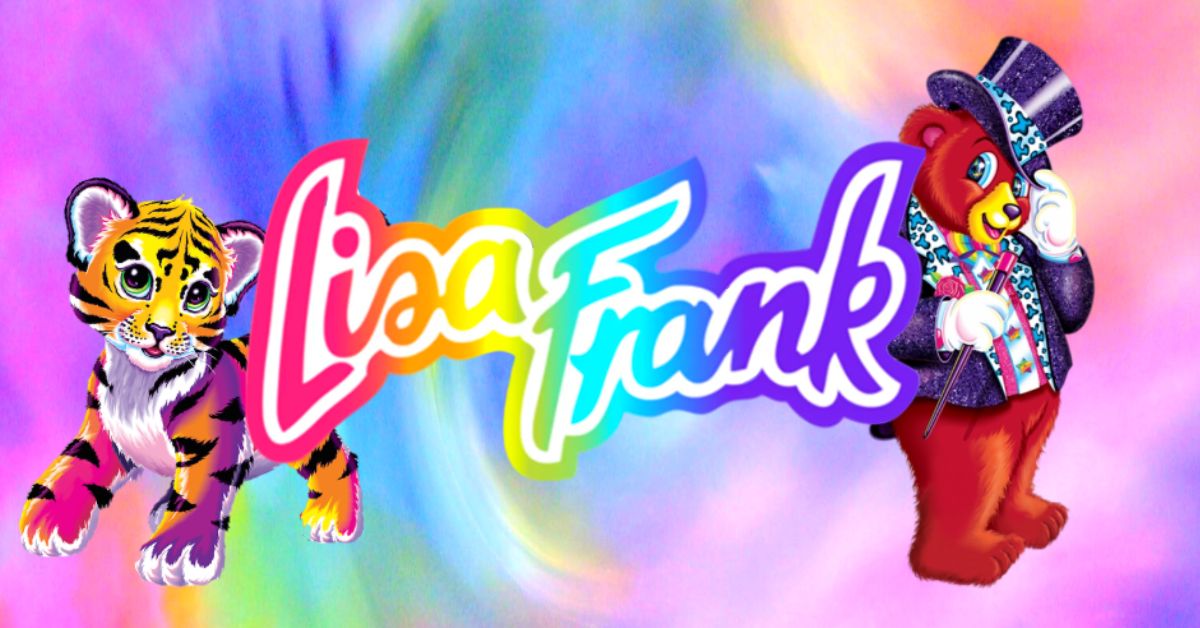
Ah, the ’80s and ‘90s; what a time to be alive. Any girl from that era will tell you all about her Tamagotchi pets, her My Little Pony toys, and, of course, her Lisa Frank everything.
In case you weren’t there, Lisa Frank was a massive brand created in 1979. The company is currently recognized for its nostalgic sparkles, unicorns, adorable pandas, and being
“the world’s sh*ttiest employer.”
No, I’m serious. That’s a true quote from Coraline, a Tuscon, Arizona resident. When she was looking for a new job, she happened to be near the headquarters. Fortunately for her, the locals had warned her about Lisa Frank Inc.’s constant rotating door.
This colorful firm, it turns out, wasn’t all sunshine and glitter. A chaotic, drunken shitshow of a business was hidden behind those brilliant blue panda eyes.
If you don’t want to have your childhood ruined, I recommend skipping this article. But, let’s be honest here, your innocence has already been damaged if you’re on the internet. So, let’s find out what happened to turn this rainbow paradise into a technicolor travesty.
The Neon Rainbow Forms
Lisa Frank is not only a brand name, but an actual person. Born on April 21st, 1955, Frank always had a passion for arts and crafts. Growing up in Detroit, she was the epitome of the “girly girl” archetype. Coloring, painting, crocheting, and ceramics were among her favorite activities. Her parents, who came from an affluent background, encouraged her to pursue her artistic passions.
During her senior year of high school, Lisa Frank made a whopping $3,000 by selling her art at an event. This notes the very first time her artwork gained monetary success. She went on to the University of Arizona to further her education.
To make some extra cash, Frank stated that she would acquire low-cost ceramics and jewelry from local Native American communities She’d then take them back home to Michigan, and slap a much higher price on them.
Yeah… kinda shady if you ask me. But I suppose from Lisa’s perspective; business was business! Of course, the overpriced artwork became a hit in her area, and she even began telling these indigenous artists exactly what to create. Chances are, they weren’t properly compensated. Regardless, Frank’s small business was her first step toward pursuing a career in entrepreneurship.
Around the age of 20, she launched the brand “Sticky Fingers,” which consisted of chunky jewelry with hand-crafted designs. This time, it was her own work, which was already being sold at places like Bloomingdales, and Neiman Marcus. Although Lisa was talented in her own right, her socioeconomic status provided a spotlight on said talent. Her family had connections to powerful people who saw the immense potential in her art style.
Lisa Frank soon renamed this brand after herself. And thus, the legend was born.
Lisa Frank EVERYTHING
Along with the name change, the brand began to offer new products. Lisa would tour a variety of museums and zoos, as well as speak with children. She was inspired to create something that reminded her of childhood; something that could transport people into a whimsical wonderland.
Backpacks, folders, pencils, notes, and stickers were among the items sold by her company. They were all covered in the most flamboyant graphics you’ll ever see. I’m talking rainbows, dolphins, multicolored leopards, bears, and of course, sparkles. You cannot forget the sparkles.
Lisa Frank, Inc. was a juggernaut. And that is putting it mildly. Not having anything Lisa Frank was social suicide in the 1980s and 1990s. At least, that’s how it went in the world of middle school girls. It was not uncommon in the ‘80s to come across a little girl decked out in Lisa Frank gear. Hell, you might’ve been one of them!
As for me personally, I, unfortunately, wasn’t around in the ‘80s or ‘90s. I was an early 2000’s kid. Regardless, shopping for back-to-school items meant coming across many Lisa Frank notebooks and folders. I may have not bought any myself (It was all about Bratz and Disney Princesses for me), but I saw plenty of classmates sporting them.
And if you were to ask 5-year-old me if she’d like to work for Lisa Frank, she would’ve jumped up for joy.
Behind The Scenes
Back when it first started, Lisa Frank INC. was just like any other big corporate business. I’m sure employees had their regular ups and downs, but it was an overall decent place to work.
That all changed, however, with the addition of Lisa’s then-husband, James Green.
James Green was originally the first in-house designer and illustrator. He worked in close proximity to Lisa Frank, and from there, they developed a relationship. Green rose through the ranks over time, eventually marrying Frank in 1994.
After having kids, Frank seemed to reconsider her business ventures. Longing to focus solely on her artwork and children, she decided to step down and let her husband take over as CEO. Doesn’t sound like a bad idea, right?
As it turns out, letting James Green take over was probably the worst mistake she’s ever made. With his attitude, illegal activity, and consistent drama, Green is credited for running his wife’s company into the ground.
James Green ran his business as an abusive authority figure. He was rumored to house substance abuse issues, which he’d carry with him every day to the workplace. Communication was sloppy and overwhelming. While working for Lisa Frank, one would expect the office space to be filled with liveliness and color. Though while the headquarters were painted that way, employees were demanded to work in complete silence. A worker would not be brought aside to speak one-on-one if they stepped a bit out of line. James Green instead chose to shout, berate, and humiliate his staff in front of their coworkers.
To top it all off, despite the company being named after his wife, Green was also rumored to be having an affair. From the workers’ perspectives, it seemed rather obvious that he and his coworker, Rhonda Rowlette, had a less than professional relationship.
I can’t confirm whether the infidelity rumor is true. Though what I can say is that he and Rhonda made the headquarters a living nightmare. Here are just a few of the horror stories from people who’ve worked for and with Lisa Frank.
- Jeffrey L Buchanan stated that when partnering with Lisa Frank, Green would be “argumentative with my buyers and relationship sources.”
- Lisa Decristofaro stated Green was responsible for canceling her health benefits. Conversations between herself and coworkers were also illegally recorded, and then played within Rhonda Rowlette’s office.
- Betty Hack stated that emails and phone calls were hacked and monitored so that the CEO knew if anyone contacted Lisa.
Furthermore, many lawsuits arose from former employees who weren’t receiving proper and timely paychecks.
Outside The Office
Unfortunately, Lisa Frank couldn’t keep their controversies inside the office. The batshit business practices found their way outside the revolving doors.
Sure there has been some minor stuff over the years, such as Lisa Frank comparing her struggles, laughably, to Michael Jackson. Or the complaints surrounding the “sexualization” of Frank’s stylized human characters.
But I’m not here to talk about those things. Lord knows every company gets its fair share of criticism. I care more about the exploitation of other creators
That’s right, we need to discuss the Lisa Frank Hotel.
The Cloudland Catastrophe
Amina Mucciolo is a visual artist, designer, and online personality. She also goes by TasselFairy on YouTube. She blew up for creating this kick-ass apartment complex.
Just taking one glance at it, you can see the absolutely stunning color, the decorative artwork, and the fun furniture. It’s not hard to understand why she went viral.
While Mucciolo may have taken inspiration from Lisa Frank, and other colorful aesthetics, it’s clear that the apartment was her own design. A design that she poured her heart and soul into. She called it “Cloudland.”
Amina Muccio was a black creator living in her dream apartment, with her art being recognized by millions. And I mean millions. She was featured in multiple magazines and news articles.
It wasn’t long before Lisa Frank’s Instagram account reached out to the artist on multiple occasions. They simply shouted her out, direct messaged her, and complimented Mucciolo on her creativity.
Seems like harmless fun, right? Well, unfortunately, this is exactly where the pleasantries end.
In 2019 (yes, that recently!), Hotels.com announced a collaboration with Lisa Frank. It included the creation of an entire apartment dedicated to her work. When photos of this “Lisa Frank flat” were posted, many people noticed how similar the layout was to Mucciolo’s.
To make matters worse, Amina Mucciolo received notice from her landlord that she would have to vacate her apartment by October of that year. Interestingly enough, this new Lisa Frank flat was owned by Barsala, who just so happens to be affiliated with Hotels.com.
So, I believe we can all agree that this landlord was looking to profit from Lisa Frank’s popularity. They tried to accomplish this by evicting Mucciolo from her apartment and repurposing it for similar reasons.
Now, to be fair, it’s unclear as to whether Lisa Frank Inc. had any direct involvement in evicting this creator. All I know is that it’s eerily similar to how this business began: by exploiting and capitalizing on smaller artists. POC artists, to be precise.
A Deserted Neon Rainbow
As I’m writing this in 2022, the Lisa Frank headquarters are deserted. The once colorful walls have faded, the outside statues have decayed, and the grass has grown out of control.
Though our nostalgia may be saddened by Lisa Frank’s downward spiral, the truth is that it was a rare diamond of its time. And, as a result of its enormous success, similar products made by independent artists are now available. Artists who are satisfied with their work, are paid fairly and are not harassed by their superiors.
If Lisa Frank’s story teaches us anything, it’s that we should respect our employees as individuals. A positive work environment is conducive to long-term success.
Business
Top 10 Best Places to Buy a Mid Century Modern Office Chair
Published
5 days agoon
July 4, 2025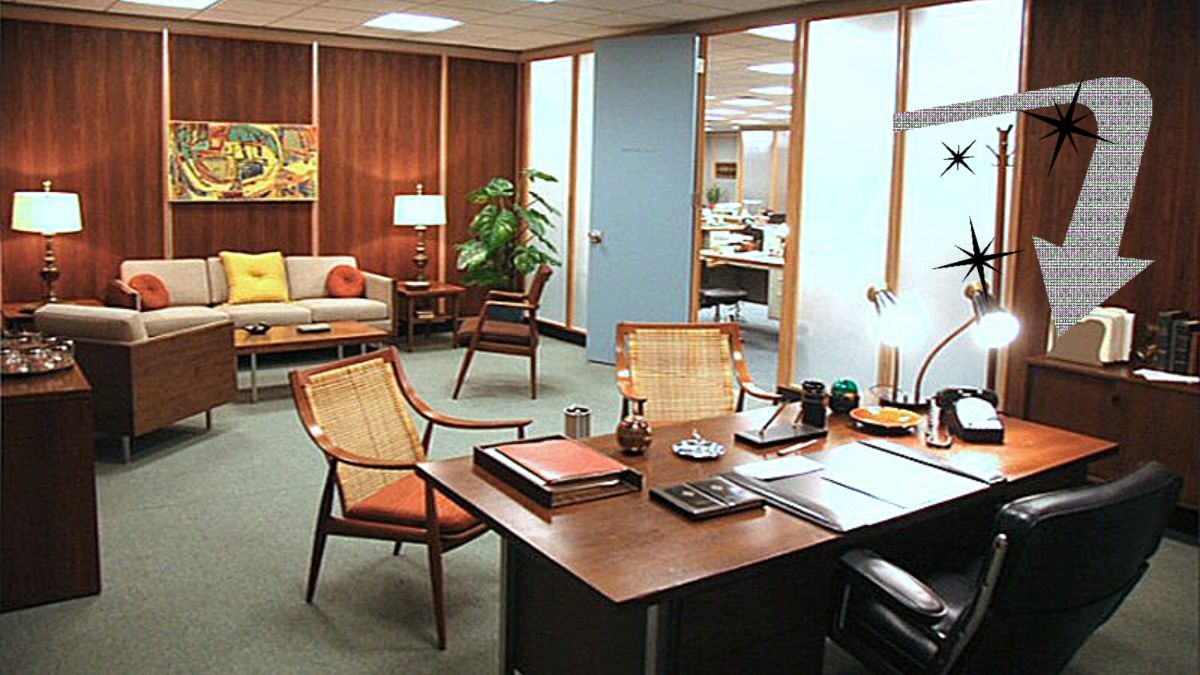
What was once old is new again: mid century modern is back in style. From architecture to furniture, the postwar look is in, and the hype extends all the way to office chairs.
Do you need a mid century modern office chair in your life? If so, there’s plenty to choose from. Your office chair should be tailored to your style, whether you like luxury, utility, or something in between.
That’s why we’ve put together our 10 favorite places to find your ideal mid century modern office chair.
What is mid century modern design?
After World War II, spirits were high in the US, and new technology was taking the country by storm. Mid century modern refers to the design concepts that came about during this time.
As opposed to the frilly, ornate designs of classical furnishings, mid century modern designs are angular, material, and functional. Wood is a common design element, especially teak. Mid century modern furniture may also have materials like glass, vinyl, and metal. Designs are simple and geometric, with bold accent colors to make them pop.
The mid century modern aesthetic never really went away, but it’s made a noted comeback in recent years. Some have chalked it up to Boomer and Gen X nostalgia, others point to mid-century-set shows like Mad Men and The Marvelous Mrs. Maisel.
Why should I buy a mid century modern office chair?
Mid century modern is the perfect fusion of style and utility. If you want to cultivate an office space that commands respect without being ostentatious, mid century modern is the style for you.
When it comes to office chairs, an MCM one is often made with sturdy wood and vinyl. They combine the ergonomics of a modern office chair with old-fashioned grace.
If you’re concerned with utility and utility only, a more bog-standard office chair may suit you. But a mid century modern office chair is great for someone who wants to wow colleagues with a mature, thoughtful business space.
Where can I get a mid century modern office chair?
1) Wayfair
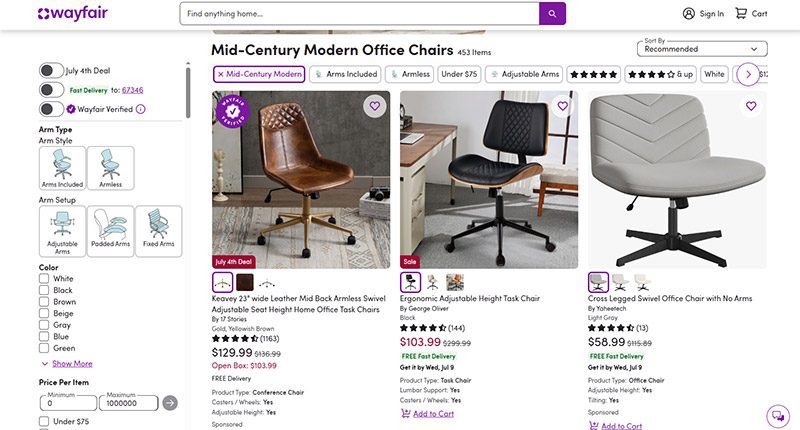
When it comes to furniture, Wayfair offers the best of both worlds. Their goods, including their mid century modern office chairs, are stylish and affordable. You can get a sturdy task chair for less than $100 or a more distinguished seat for less than $350.
MCM office chair examples: Dovray ($126), Bradford ($139), Lithonia ($133)
2) France & Son

Wayfair’s chairs are affordable, but France & Son is the perfect option for luxury shoppers. Their mid century modern office chairs are robust and sleekly designed. If you dress to impress and enjoy the finer things in life, these are the chairs for you.
MCM office chair example: Brooks ($695)
3) Houzz

Started as a community for people to share home decor tips, Houzz has become a great ecommerce platform for finding stylish furniture. They’re more known for home decor than desk chairs, but they have plenty of great, affordable finds if you know where to look.
MCM office chair examples: Arvilla ($173), Rathburn ($259)
4) Laura Davidson

The Laura Davidson collection offers a fairly limited selection of classic office furniture. Still, there’s a reason they’re trusted by big-wigs like Apple, Disney, and Salesforce. Their chairs are sturdy and beautifully designed, reimagining classic Eames and Knoll designs.
MCM office chair examples: Rockefeller ($275), SOHO II Soft Pad ($450)
5) Icons of Manhattan

Icons of Manhattan has a simple philosophy: do one thing, and do it right. Their office chairs are handcrafted from premium materials and tailored to a mid-century modern style. If you want that Mad Men energy in your office (hopefully with a lot less angst), these are the chairs for you.
MCM office chair example: Ribbed Medium ($219)
6) Amazon

Yes, the internet’s premier shopping destination has a robust collection of mid century modern office chairs. Like with most products, their selection of seats is vast and can be hit or miss. Still, they’ve got stunning chairs available for any style, whether you care about comfort, class, or ergonomics.
MCM office chair examples: IDS Home Modern ($219), Art Leon MCM Swivel ($139)
7) AllModern

AllModern’s collection of desk chairs and other furniture truly embodies the mid century modern spirit. Their work is tight, angular, and functional above all. They’re part of the Wayfair family and they traffic in a number of modern styles, but their sleek chairs are perfect for any mid century modern space.
MCM office chair examples: Frederick ($229), Kealey ($349)
8) Overstock
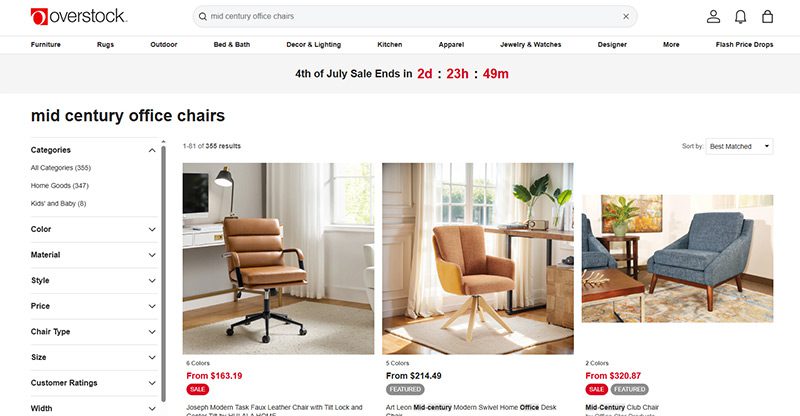
Overstock is known as a one-stop shop for quality home goods at sub-wholesale prices. If you want a spiffy mid century modern office chair that won’t break the bank, they’re the first place to look. While they’re somewhat less reliable than the more upscale platforms on this list, their selection is massive.
MCM office chair example: Joseph Modern ($163)
9) Walmart
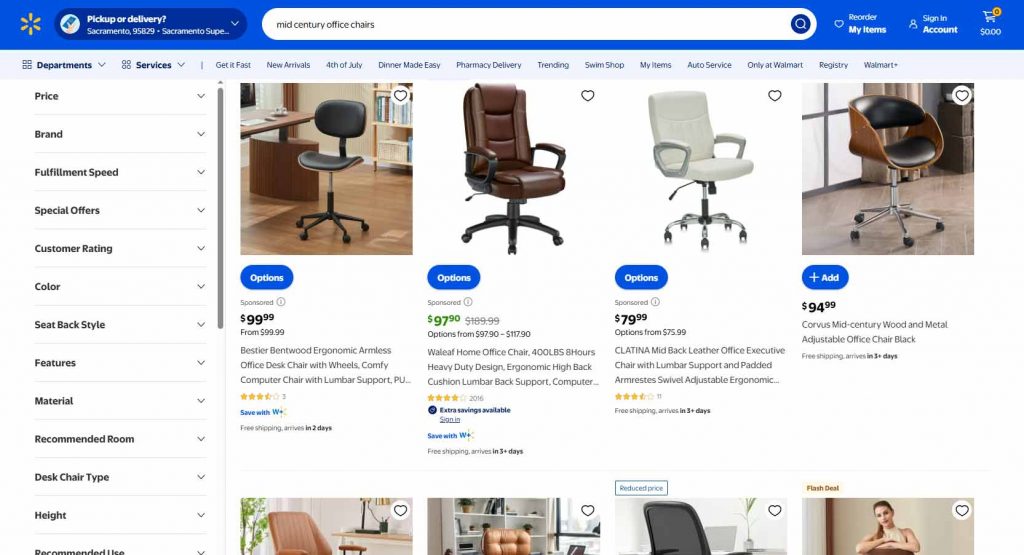
Hayneedle’s selection of mid-century modern office chairs falls somewhere between the minimal Laura Davidson and the endless Amazon catalog. Their array of mid-century designs is affordable and versatile, with chairs that match almost any style. While they may be part of the Walmart family, these chairs are anything but second-rate.
MCM office chair example: Waleaf ($97)
10) Target
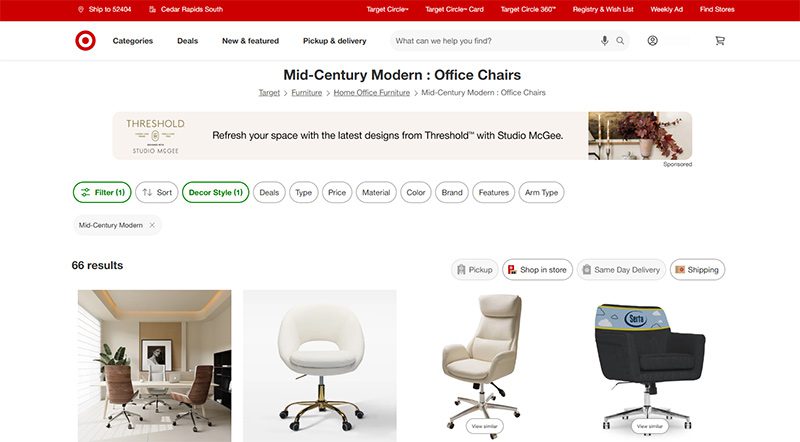
Why splurge when you can save? As usual, Target is a hidden gem, offering a sturdy selection of mid century modern office chairs for some of the cheapest prices out there. Many of the chairs they offer are from the same designers as these other stores—Christopher Knight, LumiSource, Armen Living, etc.—at reduced prices.
MCM office chair example: Lombardi ($136)

A quality payroll service is one of the most invaluable tools any entrepreneur can have. Whether you’re a small business owner or an HR manager, paying your employees on time is crucial. This makes choosing a service even more weighty, after all, it is a heavy administrative burden. The good thing is, you can outsource this duty to an online payroll processor.
According to statistics, 49% of workers begin a new job search after just two paycheck errors, and with 65% of workers living paycheck to paycheck, it’s more important than ever to ensure an efficient, effective payroll process.
These services can save you precious time and mitigate potential issues. To make it easy for you to choose, we listed the best online payroll services for 2025.
Top 5 Online Payroll Services
Gusto
Gusto is a great option for both new and experienced payroll administrators, boasting an incredibly clean user interface and a first-rate payroll setup. Gusto lets you manage your employee’s time off (vacation and sick pay), company health insurance, and worker’s comp. Gusto offers excellent mobile access, too. This allows employees to manage aspects of their Gusto profiles, view payday insights, and access Gusto Wallet financial tools.
Gusto offers four tiers of membership, the most affordable of which is the Contractor’s Only plan, which offers unlimited U.S.-based and global contractor payments, supporting more than 100 countries, plus 1099 creation and filing at a rate of $6 per person per month with no base price.
The other three are Simple, Plus, and Premium. Here’s a deeper look into each plan:
Simple
Price:
$40/mo + $6/mo per person
Plan details:
- Full-service single-state payroll including W-2s and 1099s
- Employee profiles and self-service
- Basic hiring and onboarding tools
- Gusto-brokered health insurance administration
- Employee financial benefits
- Payroll and time-off reports
- Custom admin permissions
- Integrations for accounting, time tracking, expense management, and more
Plus
Price:
$80/mo + $12/mo per person
Plan details:
(All Simple plan features +)
- Full-service multi-state payroll including W-2s and 1099s
- Next-day direct deposit
- Advanced hiring and onboarding tools
- PTO management and policies
- Time tracking and project tracking
- Workforce costing and custom reports
- Team management tools
- Full support
Premium
Price:
Bespoke pricing, reach out for a personalized quote
Plan details:
(All Plus plan features +)
- HR Resource Center
- Compliance alerts
- Access to certified HR experts
- Full-service payroll migration and account setup
- Health insurance broker integration
- R&D tax credit discount
- Waived fees and exclusive pricing
- Performance reviews
- Employee surveys and insights
- Dedicated support
QuickBooks Online Payroll
Founded in 1983, Intuit is a California-based financial software company. Since its inception, Intuit has developed into one of the best-known providers of accounting software. Their online payroll service, QuickBooks, includes the essential features you need to run payroll.
QuickBooks offers three tiers of membership. The least expensive membership covers basic accounting features, such as invoices. For more features, check out the Essentials and Plus memberships. Each plan’s features are as follows:
QuickBooks Simple Start (2025)
- Price: $38/month for 1 user
- Best for: Freelancers and small teams with basic payroll needs
Features:
- Automated bookkeeping
- 5 free ACH bank transfers/mo for bills
QuickBooks Essentials (2025)
- Price: $75/month for 3 users
- Best for: Small businesses needing deeper financial tracking
Features:
- Includes all Simple Start features, plus:
- Recurring invoices
QuickBooks Plus (2025)
- Price: $115/month for 5 users
- Best for: Growing businesses with HR and compliance needs
Features:
- Includes all Essentials features, plus:
- AI-powered profit & loss insights
- Anomaly detection and resolution
- Budgeting
QuickBooks Advanced (2025)
- Price: $275/month for 25 users
- Best for: Established businesses with HR and compliance needs
Features:
- Includes all Plus features, plus:
- Custom user management and permissions
- Custom report builder
- Data sync with Excel
- Revenue recognition
- Forecasting
OnPay

OnPay is a cloud-based full-service payroll processing system capable of running payroll according to a preset schedule, automatically disbursing wages, and calculating and withholding taxes.
OnPay can sync up with several other software your team is already using, making it easy to integrate the service into your team’s system. Another benefit of OnPays model is the simple, transparent pricing structure. No tiers; just one base rate.
Pricing:
$49/mo + $6/mo per employee
SurePayroll

SurePayroll’s award-winning service supports W-2 employees and 1099 contractors. Additionally, it handles 401(k) deductions and manages flexible spending accounts (FSA) and health savings accounts (HSA).
SurePayroll also offers a mobile app— available on both Apple and Android devices.
SurePayroll offers live support through its United States-based support team through chat, email, or phone.
Small Business Payroll
- Price: No Tax Filing: $20/month + $4 per employee, Full Service: $29/month + $7 per employee
- Best for: Small businesses and startups
Features:
- We file and deposit your federal and state taxes!
- Run payroll in 3 simple steps
- Schedule payroll to run automatically
- Unlimited payroll runs and free 2-day direct deposit
- Reports and pay stubs are available online 24/7
- Supports W-2 employees and 1099 contractors
Nanny & Household Payroll
- Price: Full-Service Household, $39/month, includes 1 employee, $10 per additional employee
Best for: Homeowners
Features:
- Signature-ready Schedule H
- We file & deposit your federal and state taxes!
- Run payroll in 3 simple steps
- Schedule payroll to run automatically
- Unlimited payroll runs and free 2-day direct deposit
- Reports & paystubs available online 24/7
- Supports W-2 employees & 1099 contractors
Be sure to choose a payroll service that works for your business, and provides you with the peace of mind that comes with a reliable bookkeeping system. Your employees will thank you.

Merck is currently in talks to acquire Seagen, a biotech company. The Wall Street Journal reports that the transaction is valued at $40 billion. And what happens if Merck acquires Seagen, and how would this acquisition benefit cancer research and treatment? Read more about the Merck Seagen buyout here.
Merck Seagen Buyout
Merck and Seagen are still deciding on their share prices. So far, talks have yet to reach an agreement on $200 per share. Both companies want to settle and finalize their deals before Merck announces its quarterly earnings on July 28. At the time of writing, Seagen’s stock was at $176.19.
With an estimated market value of $235 billion, Merck is looking to expand its presence in the cancer treatment space. The Merck Seagen Buyout could play a major role in that strategy. Since Seagen specializes in targeted cancer therapies, the acquisition would give Merck access to a broader range of oncology products.
Shareholder reactions to the new deal are overwhelmingly positive, and the stocks have been up since talks about the deal have been made public.
But this is not the first time that Merck and Seagen have made the news. Back in 2020, they collaborated because of cancer treatments. Seagen has a drug conjugate (ladiratuzumab vedotin) which would be used in conjunction with Merck’s Keytruda.
Merck reveals that Keytruda is its highest-selling product. It’s immunotherapy for cancer.
And this deal could help Merck offset the possibility of reduced sales because it will lose patent protection in 2028.
As promising as this deal is, there could be scrutiny from antitrust officials since there might be a litigation case from the Federal Trade Commission or Justice Department.
The Seagen buyout isn’t the only deal Merck has made recently. They’ve been busy closing another deal, but with Orion too.
Seagen
As a cancer biotech company, Seagen has therapies to ensure that patients benefit from the treatment and reduce any adverse side effects. Their treatments involve the therapy attacking tumors with toxins.
Merck partnering with Seagen isn’t a bad idea considering that Seagen made $1.4 billion in sales in 2021, most of it coming from Adcetris and Padcev (a treatment for urothelial cancers).
Merck-Orion Deal
In the middle of the Merck Seagen Buyout, Merck has recently partnered with Orion for the ODM-208 and other drugs. These drugs are related to the production of steroids. Orion found how it can combat hormone-dependent cancers and further developed this inhibitor.
Their deal includes that they should develop ODM-208 and promote it to the public together. And Orion will receive a $290 million payment from Merck.
Although they’re co-developing and marketing the new inhibitor, Orion will oversee the manufacturing side.
Co-developing the ODM-208 can help Merck with its current research and treatments for prostate cancer. President and CEO of Orion, Timo Lappalainen, says that this partnership will benefit Merck’s goals of treating cancer worldwide.
Other Ventures: Merck’s Role in the Pandemic
You may have heard about COVID-19 pills, which are a form of treatment for those diagnosed with mild to moderate COVID-19. Merck introduced an antiviral COVID-19 pill to the public. The name: Molnupiravir.
The COVID-19 pill is not a replacement for a vaccination. Instead, it stops the replication of the COVID-19 genetic code and keeps the patient out of the hospital. Not yet FDA-approved, Molnupiravir has been authorized for emergency use since December 23, 2021.
And for other stories, read more here at Owner’s Mag!

Top 12 Uses for The Metaverse That Will Change Your Life

Top 10 Best Places to Buy a Mid Century Modern Office Chair

The Best Online Payroll Services [Updated for 2025]

Top 10 Small Business Organization Tools for 2025

8 Best Equipment for YouTube Every Content Creator Needs

Merck Seagen Buyout: What to Know About the Deal

The Rise and Fall of Juul: Once a Silicon Valley Darling, Now Banned by FDA

What’s the Deal With Elomir? Is Axis Klarity a Scam?

Why Having an Advisory Board Could Make or Break Your Startup

Top 10 Best Places to Buy a Mid Century Modern Office Chair

8 Best Equipment for YouTube Every Content Creator Needs

The Rise and Fall of Juul: Once a Silicon Valley Darling, Now Banned by FDA

The Best Ways to Recession Proof Your Business



Robert A
June 14, 2022 at 7:48 pm
Very interesting read… didn’t know all of the behind the scenes details of the Lisa Frank story until now. My mom loved her stuff back in the 1980’s. Good stuff.
Tracy
June 18, 2022 at 6:39 pm
Love this article I remember Lisa Frank 😊
Nicky
August 20, 2022 at 4:42 pm
Well she’s blowing up all over again. Anything Lisa Frank co-branded such as Loungefly, Crocs, phone cases, Urban Outfitters, etc all sell out within minutes. Weird that the LF company doesn’t take advantage of the resurgence of interest & strike while the iron is hot.